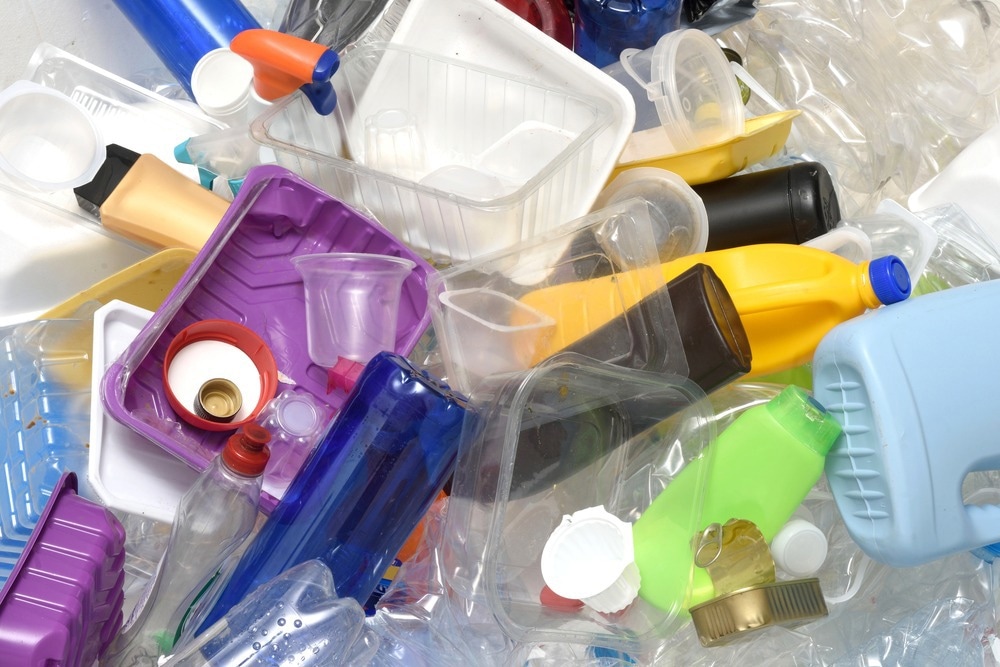A recent study reveals that advanced plastic recycling can substantially reduce greenhouse gas emissions, highlighting the potential of the pyrolysis method to revolutionize the plastics sector and promote sustainability.

Image Credit: Josep Curto/Shutterstock.com
Advanced recycling of post-use plastic (PUP) for new plastic production, as opposed to fossil-based manufacturing, has been found to lower greenhouse gas emissions (GHG) and enhance the recycling rate in the United States, according to research conducted by the US Department of Energy’s (DOE) Argonne National Laboratory. This peer-reviewed life cycle analysis study is featured in the November 2023 edition of the Journal of Cleaner Production.
This represents the inaugural examination of multiple US facilities successfully transitioning post-use plastic (PUP) all the way back into the production of new plastics, specifically focusing on low-density and high-density polyethylene (LDPE and HDPE).
The recycling process employed is pyrolysis, involving the application of high temperatures in an oxygen-free environment to plastics. The primary output is pyrolysis oil, a liquid mixture of diverse compounds suitable for use as an ingredient in the creation of fresh plastic.
This oil can effectively substitute traditional fossil-derived components such as naphtha and gases in the manufacturing of ethylene and propylene, which are pivotal monomers or fundamental building blocks for plastic production.
Advanced recycling can transform hard-to-recycle plastics into a multitude of high-value raw materials, reducing the need for fossil resources and potentially minimizing the environmental impact of waste management.
Pahola Thathiana Benavides, Study Author and Principal Energy Systems Analyst, Argonne National Laboratory
The study compiled operational data from eight different companies employing various pyrolysis oil production processes between 2017 and 2021. The analysis revealed a notable reduction in GHG emissions, ranging from 18% to 23% when producing plastic using only 5% pyrolysis oil from PUP in comparison to plastic derived from crude oil for both LDPE and HDPE, respectively.
Taking into account the existing end-of-life practices for numerous plastics in the United States, including incineration, the analysis demonstrates an additional 40% to 50% decrease in GHG emissions when producing pyrolysis-based LDPE and HDPE, respectively.
Notably, in the European Union, where a larger proportion of post-use plastic is currently incinerated, the reductions are even more substantial, reaching up to 131%.
As advanced recycling becomes increasingly efficient, it is poised to play a major role in achieving global sustainability goals by reducing waste and GHG emissions. It can transform hard-to-recycle plastics into a multitude of high-value raw materials, reducing the need for fossil resources and potentially minimizing the environmental impact of waste management.
Pahola Thathiana Benavides, Study Author and Principal Energy Systems Analyst, Argonne National Laboratory
Advanced recycling methods facilitate the utilization of PUP to create valuable industrial chemicals and expand markets for recycled plastic materials. Among these methods, pyrolysis stands out as one of the prevalent advanced technologies that are currently being implemented on an industrial scale to convert PUP into useful products, especially when traditional recycling approaches may not be suitable for repurposing this type of plastic waste.
Environmental Outcomes
While the Argonne researchers explored various scenarios involving the use of pyrolysis oil as a primary resource for the production of new plastic products (HDPE and LDPE), the most probable scenario, involving a 5% inclusion of recycled materials, exhibits the following reductions when compared to virgin production:
- Fossil energy use: 65% to 70%
- GHG emissions: 18% to 23%
- Solid waste: 116% to 118%
- Water use: 48% to 55%
In addition to GHG emissions, the Argonne team evaluated the effects on fossil energy, water usage, and solid waste when transforming PUP into new plastics. In the most probable scenario, involving 5% recycled materials, a reduction of 65% to 70% in fossil energy consumption, a 48% to 55% decrease in water usage, and a 116% to 118% reduction in solid waste were observed when compared to virgin production.
The study made use of Argonne's Greenhouse Gases Regulated Emissions and Energy Use in Technologies (GREET) model, which boasts a global user base exceeding 55,000 individuals. This model is extensively employed by the US Department of Energy (DOE) and various agencies, including the US Environmental Protection Agency.
Argonne Principal Energy Systems Analyst Uisung Lee, Energy Systems Analyst Ulises R. Gracida-Alvarez, and Interim Energy Systems and Infrastructure Analysis Division Director Michael Wang contributed to the research. The study was funded by the American Chemistry Council.
Journal Reference:
Gracida-Alvarez, U. R., et al. (2023). Life-cycle analysis of recycling of post-use plastic to plastic via pyrolysis. Journal of Cleaner Production. doi.org/10.1016/j.jclepro.2023.138867.
Source: https://www.anl.gov